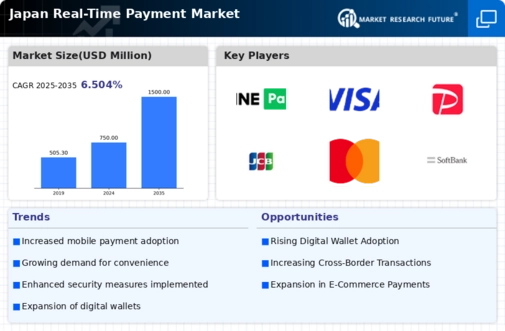Rise of E-commerce and Digital Services
The surge in e-commerce and digital services in Japan is significantly influencing the real time-payment market. As of November 2025, the e-commerce sector is projected to grow at a rate of 15% annually, driven by increasing consumer reliance on online shopping platforms. This growth is creating a heightened demand for efficient payment solutions that can facilitate quick and secure transactions. Real time-payment systems are particularly well-suited to meet the needs of e-commerce businesses, as they allow for immediate payment processing and reduce cart abandonment rates. Additionally, the proliferation of digital services, such as food delivery and online subscriptions, further emphasizes the necessity for real time-payment options. Consequently, businesses that integrate these payment solutions are likely to enhance customer satisfaction and loyalty, thereby driving the overall growth of the real time-payment market.
Consumer Demand for Instant Transactions
Consumer behavior in Japan is increasingly leaning towards the demand for instant transactions, which is a critical driver for the real time-payment market. As of November 2025, surveys indicate that approximately 70% of consumers prefer payment methods that offer immediate transaction confirmations. This shift in consumer preference is pushing retailers and service providers to adopt real time-payment solutions to meet customer expectations. The convenience of instant payments is particularly appealing in sectors such as e-commerce and retail, where speed can significantly influence purchasing decisions. Additionally, the rise of digital wallets and mobile payment applications is facilitating this demand, as they provide users with seamless and instantaneous payment experiences. Consequently, businesses that fail to adapt to this consumer demand may risk losing market share in the competitive landscape of the real time-payment market.
Increased Focus on Security and Fraud Prevention
Security concerns and the need for fraud prevention are becoming increasingly prominent in the real time-payment market in Japan. As digital transactions rise, so do the risks associated with cyber threats and fraudulent activities. As of November 2025, it is estimated that around 30% of consumers express concerns regarding the security of their online transactions. In response, payment providers are investing heavily in advanced security measures, such as biometric authentication and encryption technologies, to protect user data and enhance trust in real time-payment systems. This focus on security is likely to drive the adoption of real time-payment solutions, as consumers are more inclined to use services that prioritize their safety. Furthermore, regulatory bodies are also emphasizing the importance of security standards, which may lead to the development of more robust frameworks for fraud prevention in the real time-payment market.
Regulatory Support for Digital Payment Solutions
Regulatory frameworks in Japan are evolving to support the growth of digital payment solutions, which is a vital driver for the real time-payment market. The Japanese government has implemented various policies aimed at promoting cashless transactions and enhancing financial inclusion. As of November 2025, these regulations are expected to create a more favorable environment for fintech companies and traditional financial institutions to innovate and offer real time-payment services. For instance, the Financial Services Agency (FSA) has introduced guidelines that facilitate the licensing of new payment service providers, thereby increasing competition in the market. This regulatory support is likely to encourage investment in the real time-payment market, as companies seek to capitalize on the opportunities presented by a more dynamic regulatory landscape. The overall effect of these initiatives may lead to a more robust and diverse payment ecosystem in Japan.
Technological Advancements in Payment Infrastructure
The real time-payment market in Japan is experiencing a notable transformation due to rapid technological advancements in payment infrastructure. Innovations such as blockchain technology and artificial intelligence are enhancing transaction security and efficiency. As of November 2025, the integration of these technologies is expected to reduce transaction times significantly, with many transactions being completed in mere seconds. This shift not only improves user experience but also encourages businesses to adopt real time-payment solutions. Furthermore, the Japanese government has been actively supporting these technological developments, which may lead to increased investments in payment infrastructure. The overall impact of these advancements is likely to drive the growth of the real time-payment market, as both consumers and businesses seek faster and more secure payment options.

















Leave a Comment